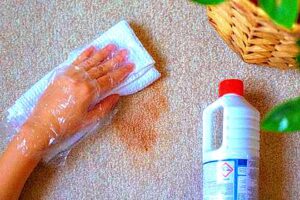 The process of dry cleaning uses solvents to clean fabrics that should not be treated with water, as well as stains that are resistant to water-based products. The dry cleaning solvents that are sold for home use are usually petroleum-based and come in powder, foam or liquid form. In this article we will talk about what exactly is the dry cleaning solvent, how often it should be used and how to properly clean with it. What is more, we will share a special homemade dry cleaning solvent recipe for those of you who prefer to use natural products.
The process of dry cleaning uses solvents to clean fabrics that should not be treated with water, as well as stains that are resistant to water-based products. The dry cleaning solvents that are sold for home use are usually petroleum-based and come in powder, foam or liquid form. In this article we will talk about what exactly is the dry cleaning solvent, how often it should be used and how to properly clean with it. What is more, we will share a special homemade dry cleaning solvent recipe for those of you who prefer to use natural products.
What is a dry cleaning solvent?
Dry cleaning solvents are petroleum-based products that dissolve dirt and soil from fabrics, without the use of water. They can be used on natural or synthetic fabrics that do not react well to water or to upholstery and carpets that cannot be easily washed.
In the early 30’s the dry cleaning industry in the US began using perchloroethylene. This quickly became the favored method for commercial dry cleaning. However, most dry cleaning solvents for home use include ingredients such as: naphtha, hexamethyldisilazane, difluoroethane, methylal, butoxyethanol and nonane.
How often to use dry cleaning?
It is advised that dry cleaning should not be the first choice for stain removal and general cleaning of things. That would be thanks to its potential toxicity, as well as its flammability. However, it is often the regular choice for certain items and fabrics. It is also perfect for removing oil-based stains, adhesives and tar.
Here is how to use dry cleaning solvent in the best way possible:
The first thing you should understand is that dry cleaning solvents are highly flammable and toxic. Whenever you decide to use such products at home, you should take some precautions. Always keep the product and the item that is being cleaned away from open fire. Do not smoke or have them near stove tops, fireplaces or gas appliances. Always make sure the air flow in the room is good – open windows and doors. Wear protective gloves, a mask and eyewear. Cleaning companies also use this method.
The next important thing you should not forget is to test the product. Make sure to apply a drop of the cleaning solvent to a hidden area of the fabric you want to clean. Wait to see if some discolouration will occur. Keep in mind that such damage cannot be repaired. If your fabric reacts to the product, do not use it.
- Remove all large/loose debris from the fabric. Vacuum it or if there is a spill, dab it with a cloth to remove most of the moisture.
- Place a small amount of the solvent on a clean cloth and dab the stain. Always work from the edges towards the center in order to prevent the stain from spreading. Do not scrub. As the dirt transfers on to the cloth, keep dabbing until no more soil is being released.
- Use a clean, dry cloth to soak up any leftover solvent from your fabric. Use another cloth, wet it and wring it until it is just damp. Dab until all traces of dry cleaning solvent are gone. Let the fabric air dry. Do not apply direct heat (such as a hairdryer).
- Check if there are any traces of the stain. If there are some, repeat the process.
Here are the tips you can follow:
- Avoid getting cleaning solvent on your skin or in your eyes.
- Always use it in a well-ventilated area because vapors are harmful.
- Some solvents feature cancer warnings.
- If you get dry cleaning solvent on a machine-washable item, make sure you remove all the product before getting the piece anywhere near the washer or dryer.
- Always test on a discrete area to make sure you don’t do more bad than good.
- Use solvent sparingly.
Here is a recipe you can try out. Whenever you want to clean your sofa, armchair or anything else that is not so easy to wash but needs a good cleaning and you want to skip using those toxic, full of chemicals , commercial products, mix it and enjoy.
You will need:
¾ cups water
4 tbsp vinegar
1 tsp borax
1 tsp oxygen bleach
zip top pillowcase
washcloth
mixing container
In the bowl, combine the wet ingredients, add the dry ones and mix thoroughly. To use, soak in a white cloth and wring it out. Put it in the bag with the clothing. Dry for 20 minutes, pull out and dry. This will refresh and clean your clothes.
An Interesting Fact: From the mid-nineteenth century into the early part of the twentieth century, dry cleaners would use all kinds of highly flammable solvents which caused a number of fires. For a while the dry cleaning industry was considered dangerous. The solvents used included: Turpentine, Kerosene, White Gasoline, Benzene, Camphene, Camphor Oil, Naphtha, Carbon Tetrachloride.
